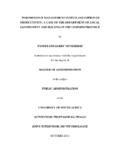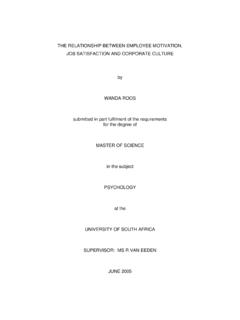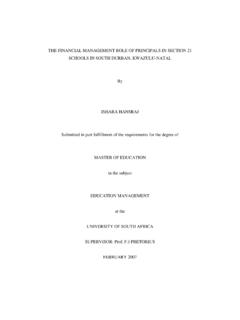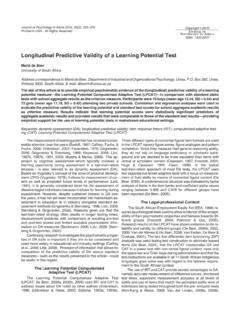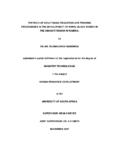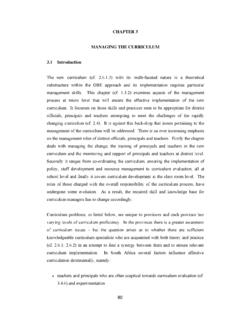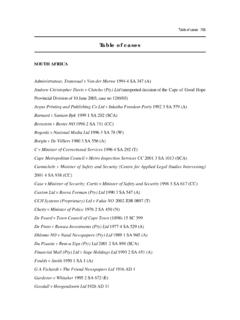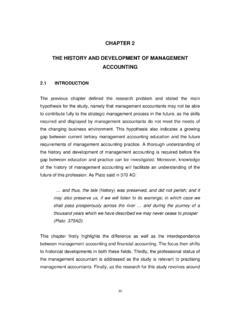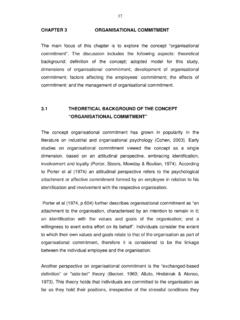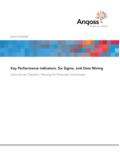Transcription of Chapter 3 Data analysis, findings and literature …
1 23 Chapter 3 data analysis , findings and literature review INTRODUCTION Chapter 2 described the research design and methodology. This Chapter discusses the research findings with reference to the literature reviewed. SAMPLE Sampling is the process of selecting a portion of the population to represent the entire population (Polit et al 2001:233). The population refers to individuals in the universe who possess specific characteristics, or a set of entities that represent all the measurements of interest to the researcher (De Vos, Strydom, Fouch & Delport 2004:209). In this study, the researcher used an accessible population to represent a targeted population. The researcher used purposive sampling to select the respondents. This was done to ensure that the sample adequately represented the target population, to obtain the most relevant information, and to allow informational adequacy and appropriateness of data .
2 The sample was drawn from a population of newly initiated young men, aged between 15 and 20, who volunteered to participate in the study. Three groups from different locations in East London in the Eastern Cape Province were invited to voluntarily participate in the study. Two groups were drawn from a public high school and the third group consisted of young males who were undergoing training as student nurses in a public general hospital in East London. The first two groups consisted of four participants each and the other group consisted of six participants. The interviews were conducted until saturation of data was reached. According to Polit et al (2001:470), data saturation is the process of collecting data in a grounded theory study to the point where a sense of closure is achieved because new data yield redundant information.
3 In this study data saturation was reached when the participants 24repeatedly gave same information and no new information emerged during the interviews. Table represents the distribution of respondents in the focus groups. Table Distribution of newly initiated Xhosa men in focus group interviews Group Number of participants Code Group 1 Four participants from a public school A-D Group 2 Four participants from a public school E-H Group 3 Six participants from a general hospital I - N data COLLECTION The researcher bracketed his thoughts and perceptions about the research topic. Polit et al (2001:458) describe bracketing in phenomenological research as the process of identifying and holding in abeyance any preconceived beliefs and opinions about the phenomenon under study.
4 It was essential to allow the participants to describe their experience openly and freely. The researcher remained interested, attentive and non-judgemental and did not lead the participants on. The researcher had no difficulty gaining entry to the public school and obtaining permission to conduct the study. A letter from Unisa requesting permission to conduct the study was presented to the principal of the high school concerned (see appendix A). The principal appreciated the benefit that the pupils would gain after the researcher explained the purpose of the study. Furthermore, the principal requested that health talks be given to prepare young boys before they undergo circumcision in order to reduce the problems experienced during traditional circumcision.
5 The participants were initially reluctant because of the sensitive nature of the topic. They feared being victimised by their communities since open discussion of the custom of circumcision is not encouraged. It is also taboo for individuals who have not yet undergone circumcision to have any knowledge of the subject. The participants also feared that their names would appear in media and the consequences they would face should they be found divulging information about circumcision. Finally, after explaining the significance and purpose of the study and assuring them of anonymity and confidentiality, the learners agreed to participate in the study. The researcher then arranged to conduct the interviews at a suitable time. 25On the appointed day, the researcher was shocked to find that the participants were not available to participate in the interviews.
6 In this way, the researcher learned the importance of arriving before the scheduled time in order to meet the participants before they changed their minds. Another appointment was arranged through the schoolteacher who served as facilitator. The participants honoured the second appointment. The researcher explained the purpose of the study and the participants rights, including confidentiality, anonymity, and to withdraw from the study at any time should they so wish. Informed consent was obtained from each participant (see appendix C). A few participants felt uncomfortable about the use of a tape recorder during the interviews but explaining the need for it and reassuring them of confidentiality and anonymity addressed their concerns. They were allowed to choose names or letters to identify themselves during the recording of the interviews.
7 The number of participants willing to participate in the study determined the size of the group. The researcher decided to divide the group into two groups so that it was possible to control the group during the interviews. As the study progressed the researcher gained more confidence and skills to control and direct the interviews in order to obtain explicit descriptions of the participants experience of traditional circumcision rites. Rich data was collected from the interviews. Transcribing the data was a time-consuming task. After transcription the researcher analysed and coded the data . Then the transcriptions were referred to an expert in qualitative research to confirm the findings . data analysis The process of data analysis followed a combination of two methods, Creswell (1994:155) eight steps of qualitative data analysis and method described by Appleton (1995:994-997) which was earlier proposed by Miles and Huberman (1994:324).
8 The Creswell's method has been elaborated in detail in Chapter 2. This method is based on three stage analysis , that is data reduction, data display and conclusion drawing. 26 The researcher analysed the data using Creswell s (1994:155) eight-step and Appleton s (1995:995) three-stage method (cited in Miles & Huberman s 1994:324). The eight-step method was described in Chapter 2. The three-stage method consists of data reduction, data display and conclusion drawing. data reduction Appleton (1995:995) refers to data reduction as the process of selecting, focusing, simplifying, abstracting and transforming the data as the researcher elicits meanings and insights from the words of the respondents . The researcher listened to and transcribed each tape and then read each transcript several times to familiarise himself with the data .
9 Each transcribed interview was coded, re-analysed and broken down into categories and themes. Finally, the themes were reviewed in the context of each interview. data display During data collection and analysis four themes and their subcategories emerged from the interviews (see table ). Table Themes associated with the respondents experience of circumcision Theme Categories Experience of performance of the ritual Proper performance of the ritual Improper/poor performance of the ritual Social pressure associated the ritual Lack of acceptance in the community by peers. by members of the opposite sex Lack of respect by initiates by members of the opposite sex Social pressure to abuse substances substance abuse of initiates substance use by traditional attendants (ikhankata) substance use after circumcision Stigmatisation associated with the ritual Labelling Prejudice Discrimination associated with the ritual Acceptance issues THEMES Four themes emerged from the data analysis .
10 The researcher identified categories and subcategories of themes. The themes deal with the respondents experience of circumcision. Theme 1: Performance of circumcision This theme deals with the performance of circumcision as experienced by the respondents. The categories identified were proper performance and improper or poor performance of circumcision (see table ). Table Experience f performance of circumcision Theme 1 Categories Proper performance Experience of performance of circumcision Improper or poor performance Proper performance There are two perspectives on the proper performance of circumcision. The first perspective adheres to the health standards in traditional circumcision prescribed by the Circumcision Act, 6 of 2001 (South Africa (Republic) 2001:5).
